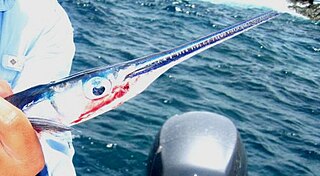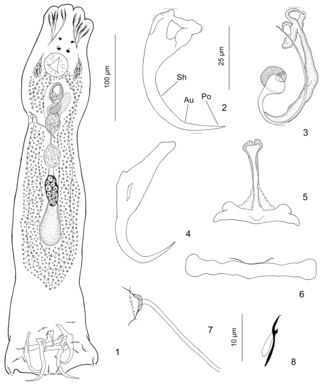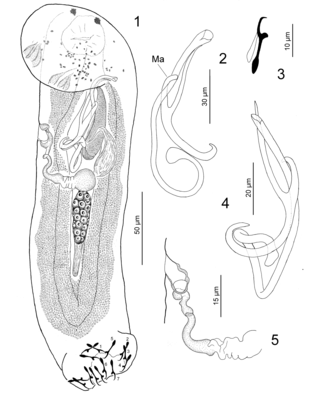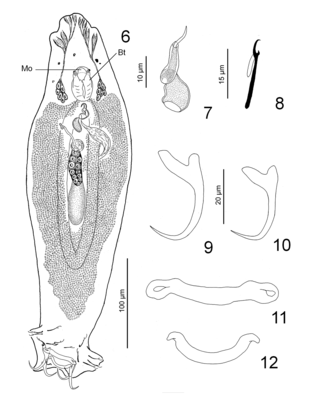
Needlefish or long toms are piscivorous fishes primarily associated with very shallow marine habitats or the surface of the open sea. Some genera include species found in marine, brackish, and freshwater environments, while a few genera are confined to freshwater rivers and streams, including Belonion, Potamorrhaphis, and Xenentodon. Needlefish closely resemble North American freshwater gars in being elongated and having long, narrow jaws filled with sharp teeth, and some species of needlefishes are referred to as gars or garfish despite being only distantly related to the true gars. In fact, the name "garfish" was originally used for the needlefish Belone belone in Europe and only later applied to the North American fishes by European settlers during the 18th century.
The keeltail needlefish, sometimes called the keeled needlefish, is a tropical fish of the family Belonidae. It was described by the French naturalist Charles Alexandre Lesueur in 1821.

The flat needlefish, or barred longtom, the only known member of the genus Ablennes, is a marine fish of the family Belonidae. Flat needlefish are considered gamefish, frequently caught with the help of artificial lights, but are not often eaten because of their green-colored flesh.
Bothriocephalus acheilognathi, also known as the Asian tapeworm, is a freshwater fish parasite that originated from China and Eastern Russia. It is a generalized parasite that affects a wide variety of fish hosts, particularly cyprinids, contributing to its overall success.

The Atlantic needlefish is a common demersal needlefish species common in marinas and other areas with minimal currents. Its extremely long jaw and body set this fish apart from other predators. Atlantic needlefish are found from Maine to Brazil and have been known to venture into fresh water for short periods.

Pterygodermatites is a genus of parasitic nematodes in the family Rictulariidae. Their life-cycle is complex. Species include:

Strongylura is a genus of needlefishes from the family Belonidae which is distributed throughout the tropical and warmer temperate waters of the world, including some species which live in freshwater.

Tylosurus is a genus of needlefish, one of ten in the family Belonidae. They are found worldwide in tropical and warmer temperate seas and two species have been recorded as Lessepsian migrants in the eastern Mediterranean Sea.
Cacatuocotyle is a genus of monogeneans.

Pseudorhabdosynochus is a genus of monopisthocotylean monogeneans, included in the family Diplectanidae. The type-species of the genus is Pseudorhabdosynochus epinepheli .

Pseudorhabdosynochus capurroi is a diplectanid monogenean parasitic on the gills of the Black grouper, Mycteroperca bonaci. It was described by Vidal-Martínez and Mendoza-Franco in 1998 and redescribed successively by Yang, Gibson and Zeng in 2005 and by Kritsky, Bakenhaster and Adams in 2015.

Aristocleidus is a genus of monogeneans erected by Justus F. Mueller in 1936. The genus has been revised by Delane C. Kritsky and Edgar F. Mendoza–Franco in 2008. The amended generic diagnosis is: species with gonads overlapping, ventral anchors with deeply incised base forming deep and superficial roots, a coiled tube of the male copulatory organ in a clockwise orientation, and haptoral hooks with upright acute thumb, slender shank comprising one subunit and FH loop.

Ancyrocephalidae is a family of monogenean flatworms. The family is considered as a "temporary name" in WorMS but includes a large number of genera and species.

František Moravec is a Czech parasitologist who specialises on the Nematodes, especially the nematodes parasites of fishes. His research is mainly in the field of taxonomy of the Nematoda.

Paracolpenteron hubbsii is a species of dactylogyrid Monogenean. It is the single species of the genus Paracolpenteron. It is a parasite of the urinary bladder of the maya needlefish Strongylura hubbsi (Belonidae).
Octouncuhaptor is a genus of monopisthocotylean monogeneans in the family Ancyrocephalidae.
Rhabdosynochus is a genus of monopisthocotylean monogeneans, belonging to the family Diplectanidae.
Microcotyle oceanica is a species of monogenean, parasitic on the gills of a marine fish. It belongs to the family Microcotylidae. It was first described and illustrated based on two specimens from the gills of the Mexican needlefish Tylosurus fodiator (Belonidae), off Panama.
Strongylura strongylura, the spottail needlefish or blackspot longtom, is a species of needlefish from the family Belonidae. It is found in the Indian and western Pacific Oceans from the Persian Gulf east to Australia and the Philippines. This species occurs in coastal waters and in mangrove-lined lagoons as well as being recorded in estuarine areas and it has even entered freshwater. Living S. strongylura have been found alive and buried in mud during low tide. It is piscivorous, feeding mainly on clupeoids. This species is oviparous and the eggs adhere to objects in the water which catch the tendrils which cover the surface of the egg. Strongylura strongylura under the synonym of Strongylura caudimaculata is the type species of the genus Strongylura. It as originally described as Belone strongylura by Johan Coenraad van Hasselt in 1823 with the type locality given as Vizagapatam, India.

Ancyrocephalus is a genus of flatworms belonging to the family Ancyrocephalidae.












